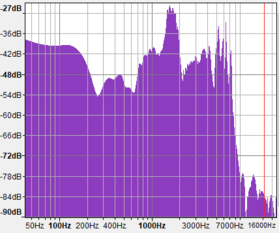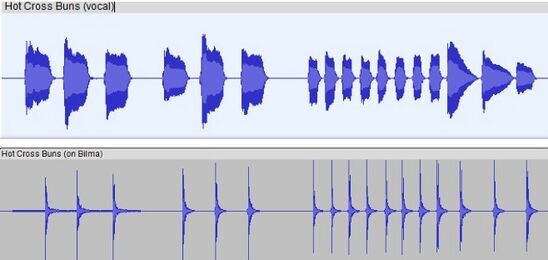PHYS341/2023/Project21
The Native Australian Bilma (clapstick)
A clapstick, or referred to as “bilma” or “bimla”, is a percussive instrument carved out from cooktown ironwood that is used in Native Northern Australian aboriginal chants during regional celebrations and ceremonies [1]. It is occasionally used to accompany other instruments like a didgeridoo. They were first originally used for digging holes and hunting wild animals, before they were ever used as instruments.
Qualities and Dimensions
The bilma usually has a length shorter than a standard 30-cm ruler with varying diameters and patterns. Unlike drumsticks which have a sudden decrease in the diameter running from the shaft to the shoulder and the tip, bilmas maintain the same diameter along its length before the wood curves and narrows into a point on both sides. The grooves made on the wood are unique and provide decent grip. As an instrument, it belongs to the class of concussion ideophones.
Because the instrument lacks any variation in its shape or contains an air cavity, the fundamental frequency would be the same and the spectrogram would contain a similar range in loudness. Loudness is controlled by either decreasing or increasing the force. Timbre remains unaffected unless the object that is being whacked is changed.
Playing Technique

The bilma is played with the same technique as striking the drumsticks together. Because I do not have two of these clapsticks, I decided to use a denser seashell that is at least approximately 0.25cm thick in curvature because it has a unique and somewhat irregular shape. Only one clapstick would be analyzed for its individual components. To be consistent with referring to the same instrument, I would refer to the instrument as a “bilma” instead of a clapstick.
In this experiment, the 2 conditions are striking the bilma at the end and at the centre onto the same seashell. All test-runs for both conditions are set in the standard time signature (4 beats/bar). In each condition, the bilma is struck for only 1 bar of sheet music, a total of four times onto a convex surface. I decided not to strike the concave surface of the seashell because it is impossible to strike the center of a stick into a concave surface.
Frequency Variations
In one instance from playing the bilma, the frequency was able to change from 144Hz (D3) to around 137Hz (C#3/Db3) when striking the end of the bilma and then the center of the bilma against the convex surface of the seashell. Based only on this semitone difference, sharper notes are produced at the pointed end of the bilma whereas its flatter counterparts are produced closer to the center of the bilma.
Even though there is a small difference in these frequencies that are heard, striking the same area with the same motion could still produce random notes for at least ¼ bilma strikes in the same test-run. Based on this assumption, there are specific frequencies emitted independently for each time the bilma is struck. The frequencies produced from the bilma are fairly random and cannot organize notes on a register like a xylophone. It is possible for the difference found between different lengths of the bilma to be larger than a semitone, but it is generally impossible for it to play any chords, provided that the frequencies are random.


Spectra of Sound
Observing the spectrum graphs, we can see that for the 2nd harmonic, striking at the bilma's end is observed to have a higher frequency than striking at the bilma's center. This is related to the semitone difference as mentioned previously in the results. At the highest peak of the spectrogram, the end of the bilma in figure 2 has a similar fundamental frequency with the center of the bilma in figure 3, sitting at around 2000Hz, so the harmonic differences are subtle. To observe this comparison, I decided to play Hot Cross Buns on the bilma and compared it to the singing voice.

After covering a simple tune like “Hot Cross Buns” and comparing the sinusoidal waveform of the bilma to the singer’s voice in figure 5, it is only the rhythm of the song produced from both of them that is accurate.

The human voice and the bilma have complementary, but different properties from each other. Because the bilma lacks resonance, its sound waves are shortly fixed and decays with each concussive striking. A singing voice can match the correct pitch for each note and hold the sound for a variable amount of time which allows it to have a more consistent wave pattern. This goes the same for brass and woodwind instruments. Because the bilma’s irregular wave pattern distracts our ears from picking up a clear note, the sounds it produces would be characterized as just noise and more suitable for contributing a specific set of frequencies like having different drum set patterns and make for exceptional emphasis in the background to a song or a chant.
Sources
- ↑ Roberts, J. (2017, June 21). "Clapsticks. Archives and Special Collections". Check date values in:
|date=(help)